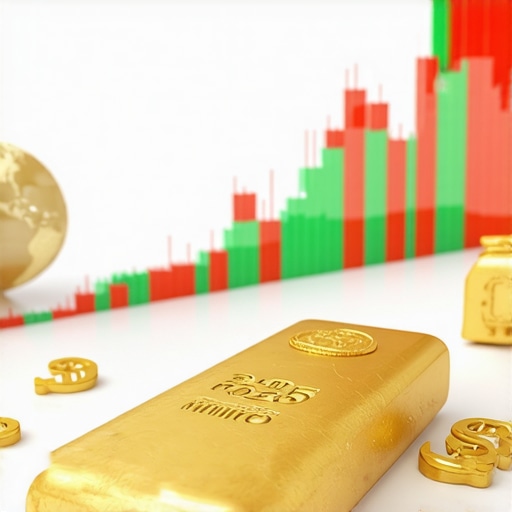Understanding the Dynamics of Gold Demand and Price Fluctuations
Gold has always held a special place in the global market, not just as a precious metal but as a coveted asset for investors. Understanding how to navigate the effects of gold demand on prices today is crucial for those looking to secure their investments. Various factors influence gold prices, including economic indicators, geopolitical tensions, and shifts in consumer demand.
Factors Influencing Gold Demand
The demand for gold can be categorized into several key segments, each impacting pricing in distinct ways. Investment demand, jewelry demand, and central bank purchases are among the most significant influences. For instance, during times of economic uncertainty, investors often flock to gold as a safe haven asset. This increased investment demand can drive prices up substantially. For a deeper exploration of investment strategies, check out our article on best gold investment strategies.
Another critical aspect is the demand from emerging markets, particularly in Asia. Countries like India and China have historically been major consumers of gold for jewelry and ceremonial purposes. As these economies grow, their appetite for gold tends to increase, further influencing global prices. This trend underscores the importance of understanding how global demand impacts gold prices.
Economic Indicators and Gold Prices
Gold prices are also closely tied to various economic indicators such as inflation rates, currency strength, and interest rates. Typically, when inflation rises, the value of currency diminishes, prompting investors to turn to gold as a hedge against inflation. This behavior can create a surge in demand, consequently driving prices higher.
Additionally, the relationship between gold and interest rates is noteworthy. When interest rates are low, the opportunity cost of holding gold decreases, making it a more attractive investment. Conversely, as interest rates rise, gold may lose its appeal, leading to a drop in demand and prices. For insights on how to effectively analyze these economic factors, explore our guide on assessing gold trading conditions.
Geopolitical Influences on Gold Demand
Geopolitical events can create significant volatility in gold prices. For instance, conflicts, trade wars, and political instability often lead to increased gold demand as investors seek safety amidst uncertainty. Keeping abreast of current events and understanding their potential impact on gold prices is essential for making informed investment decisions. To delve deeper into how geopolitical factors impact gold prices, consider reading our analysis on geopolitical events and gold prices.
In conclusion, navigating the effects of gold demand on prices today requires a multifaceted approach. By understanding the key factors that drive demand, including investment patterns, economic indicators, and geopolitical influences, investors can make more informed decisions. As the gold market continues to evolve, staying informed will help you seize opportunities and mitigate risks in your investment journey.
Long-Term Trends in Gold Demand
Analyzing long-term trends in gold demand is essential for investors aiming to make strategic decisions. Over the years, gold has maintained its status as a preferred asset for wealth preservation. The historical data indicates that gold demand tends to rise during economic downturns and uncertainty. This pattern highlights the importance of recognizing key indicators for investors when planning your investment strategy.
Types of Gold Investments
Investors have various options when it comes to gold investments, each with its unique characteristics and risk profiles. Common types include physical gold like coins and bars, gold ETFs, and gold mining stocks. Understanding the differences between these investment types is crucial for building a well-rounded portfolio. For instance, physical gold is often seen as a tangible asset, while gold ETFs offer liquidity and ease of trading. To explore these options further, refer to our article on the best gold coins to invest in.
Gold ETFs vs. Physical Gold
When considering gold investments, many investors debate between gold ETFs and physical gold. Gold ETFs provide a convenient way to invest in gold without the hassle of storage and insurance. However, physical gold can offer emotional and psychological benefits, as it is a tangible asset that investors can hold. Understanding the pros and cons of both can help you make an informed choice, which is why our guide to physical gold vs. ETFs is a must-read.
Understanding the Impact of Economic Policies on Gold Prices
Economic policies, including interest rate adjustments and quantitative easing, play a significant role in influencing gold prices. Central banks around the world often turn to gold as a means of diversifying their reserves. When monetary policy is expansionary, the money supply increases, which can lead to inflation and subsequently raise gold prices. It’s critical for investors to monitor central bank actions and economic forecasts to understand potential shifts in gold prices. For expert insights on these economic shifts, consult our analysis on how economic shifts impact gold prices.
Global Economic Factors Affecting Gold Demand
Global economic factors, such as GDP growth rates and employment statistics, directly influence gold demand. In periods of economic growth, consumer confidence typically increases, leading to higher jewelry demand and investment purchases. Conversely, during economic contractions, gold often experiences a spike in demand as investors seek safe-haven assets. Keeping an eye on these trends allows investors to anticipate market movements and adjust their strategies accordingly.
Conclusion: Strategies for Navigating Gold Investment
As the gold market evolves, understanding the myriad factors affecting demand and prices becomes increasingly vital. By honing in on market trends, types of investments, and economic indicators, investors can navigate the complexities of gold investing with confidence. With informed strategies, you can position yourself to capitalize on opportunities in the gold market. For a comprehensive view of investment strategies, visit our page on investment strategies for gold.
Gold Investment Strategies: Positioning for Success
To maximize returns in the gold market, it’s essential to adopt informed investment strategies. Investors should consider their risk tolerance, investment horizon, and market conditions when developing their approach. Diversifying your gold investments can be an effective strategy to mitigate risks. For example, incorporating gold mining stocks alongside physical gold and ETFs can provide a balanced portfolio. Explore strategies that align with your financial goals by checking our detailed guide on the best gold investment strategies.
Leveraging Market Trends
Understanding market trends is crucial for gold investors. Factors such as inflation rates, currency fluctuations, and geopolitical tensions can significantly influence gold prices. For instance, during periods of high inflation, gold often serves as a hedge, increasing in value. Keeping abreast of current events and economic reports can help investors make timely decisions. Our article on how global demand impacts gold prices provides valuable insights into these dynamics.
Analyzing Historical Gold Price Trends
Historical price trends provide context for current gold market conditions. By analyzing past performance, investors can identify patterns and make predictions about future movements. For instance, significant price spikes often occur during crises or economic instability, making it important to recognize these signals. If you’re keen on understanding past trends and their implications, visit our analysis on gold price trends.
Understanding Investor Behavior in Gold Markets
Investor behavior plays a pivotal role in gold price fluctuations. Emotional reactions to market news can lead to volatility, influencing buying and selling patterns. Recognizing how market psychology affects gold investments can provide an edge. A well-informed investor can anticipate these changes and adjust strategies accordingly. Learn more about investor behavior in our piece on gold market analysis.
Preparing for Future Gold Investment Opportunities
As we look toward the future, staying informed about potential gold investment opportunities is vital. With emerging markets and evolving economic conditions, new avenues for investment are continually opening. For example, gold IRAs are becoming increasingly popular as a means of investing in physical gold while enjoying tax benefits. To understand how to navigate these opportunities, refer to our article on investing in gold IRAs.
Risks Associated with Gold Investments
While gold can be a sound investment, it is not without risks. Market volatility, storage costs for physical gold, and regulatory changes can impact returns. Understanding these risks allows investors to prepare and implement strategies that minimize potential losses. For comprehensive insights into the risks of investing in gold, check out our guide on the risks of investing in gold stocks.
Conclusion: Embracing Informed Gold Investment Choices
In conclusion, navigating the gold market requires a keen understanding of various factors, including economic conditions, historical trends, and investor behavior. By leveraging this knowledge, investors can make informed decisions that align with their financial goals. To stay ahead in the gold investment landscape, keep exploring the available resources and strategies. For a deeper dive into effective investment techniques, visit our page on investment strategies for gold.
Advanced Gold Investment Techniques for 2025
As we move deeper into 2025, investors are exploring advanced techniques in gold investment to maximize their returns. Understanding these strategies is essential for adapting to the ever-changing market landscape. Utilizing innovative approaches can provide a competitive edge in achieving optimal portfolio performance.
Diversification Beyond Traditional Gold Assets
Diversifying your investments is a critical strategy. While traditional gold assets like coins and bullion are foundational, incorporating other forms such as gold mining stocks and gold ETFs can enhance your portfolio. By blending these assets, investors can mitigate risks and capitalize on various market conditions. Each investment type reacts differently to economic changes, providing a balance that can safeguard against volatility.
Utilizing Gold Futures for Strategic Gains
Gold futures are another sophisticated investment tool that can yield significant profits if used correctly. These contracts allow investors to speculate on future gold prices, providing opportunities to profit from price movements without having to own the physical gold. However, trading futures requires a solid understanding of market trends and timing. Our post on strategies for investing in gold futures offers insights into effectively utilizing this approach.
Monitoring Global Economic Indicators
Keeping an eye on global economic indicators is vital for successful gold investment. Factors such as inflation rates, interest rates, and geopolitical events can significantly impact gold prices. For instance, a rise in inflation typically drives investors toward gold as a safe haven. To stay informed about these developments, refer to our article on how global factors influence gold demand trends.
Understanding Gold Investment Risks and Mitigation Strategies
Investing in gold, like any other asset, comes with its risks. Volatility, market fluctuations, and geopolitical tensions can affect gold prices. Implementing risk mitigation strategies is crucial for protecting your investments. One effective approach is to regularly rebalance your portfolio to maintain your desired asset allocation. For more details on understanding the risks associated with gold investments, visit our guide on the risks of investing in gold stocks.
Building a Resilient Gold Investment Portfolio
A resilient gold investment portfolio is essential for navigating market uncertainties. This involves not only diversifying your assets but also being adaptable to changing market conditions. Regularly reviewing your investment strategy and being open to new opportunities can help in capitalizing on market shifts. To learn more about building a robust investment strategy, check our post on investment strategies for gold.
Understanding Gold Investment Risks and Mitigation Strategies
Investing in gold, like any other asset, comes with its risks. Volatility, market fluctuations, and geopolitical tensions can affect gold prices. Implementing risk mitigation strategies is crucial for protecting your investments. One effective approach is to regularly rebalance your portfolio to maintain your desired asset allocation. For more details on understanding the risks associated with gold investments, visit our guide on the risks of investing in gold stocks.
Building a Resilient Gold Investment Portfolio
A resilient gold investment portfolio is essential for navigating market uncertainties. This involves not only diversifying your assets but also being adaptable to changing market conditions. Regularly reviewing your investment strategy and being open to new opportunities can help in capitalizing on market shifts. To learn more about building a robust investment strategy, check our post on investment strategies for gold.
Frequently Asked Questions About Gold Investment
1. What are the benefits of investing in gold?
Investing in gold offers several benefits, including portfolio diversification, a hedge against inflation, and protection during economic downturns. Gold often retains its value over time, making it a solid long-term investment.
2. How does gold act as a hedge against inflation?
Gold typically retains its purchasing power during inflationary periods. As the value of currency declines, gold prices often rise, making it a safe store of value that can help protect your wealth.
3. What factors influence the price of gold?
The price of gold is influenced by various factors, including supply and demand dynamics, geopolitical events, currency fluctuations, and market speculation. Understanding these factors can help investors make informed decisions.
4. Should I invest in physical gold or gold ETFs?
Choosing between physical gold and gold ETFs depends on your investment strategy. Physical gold offers tangible value and can be a safe haven, while gold ETFs provide liquidity and ease of trading, making them suitable for active investors.
5. How can I mitigate risks when investing in gold?
To mitigate risks, consider diversifying your gold investments across different assets, regularly rebalancing your portfolio, and staying informed about market trends and economic indicators.
6. Is gold a good long-term investment?
Many investors view gold as a good long-term investment due to its historical stability and ability to retain value. It can serve as a reliable part of a diversified investment portfolio.
7. What are the best times to invest in gold?
While timing the market can be challenging, investing during periods of economic uncertainty or inflation can be beneficial. Additionally, monitoring global economic indicators can help identify favorable entry points.
8. How do I start investing in gold?
To start investing in gold, determine your investment goals, choose your preferred method (physical gold, ETFs, mining stocks, etc.), and research reliable dealers or platforms to make your purchases.
9. Can I invest in gold with a retirement account?
Yes, you can invest in gold through a self-directed IRA (SDIRA) that allows for alternative investments. This can include physical gold, gold ETFs, and mining stocks, offering tax advantages for retirement savings.
10. What is the outlook for gold prices in 2025?
While predicting gold prices can be difficult, analysts suggest that ongoing economic uncertainties, inflationary pressures, and geopolitical tensions may drive demand for gold, potentially leading to price increases in 2025.
Authority Resources for Gold Investment
For further insights and in-depth analysis on gold investment, consider exploring the following trusted resources:
- World Gold Council – A leading authority on gold, providing research, data, and insights into gold markets.
- Investopedia – Offers comprehensive guides and articles on various aspects of investing, including gold.
- Kitco – A well-known source for live gold prices, charts, and market news.
- Bloomberg – Provides up-to-date financial news and analysis, including gold market trends.
- Forbes – Features articles and expert opinions on investment strategies, including gold.
Conclusion
In conclusion, as you navigate the complex landscape of gold investment in 2025, it is crucial to adopt advanced techniques and strategies tailored to your financial goals. From diversifying your portfolio to utilizing gold futures, understanding the risks, and keeping informed about market indicators, these approaches can significantly enhance your investment outcomes. By leveraging reliable resources and staying adaptable, you can maximize your gold investment potential and secure your financial future.










